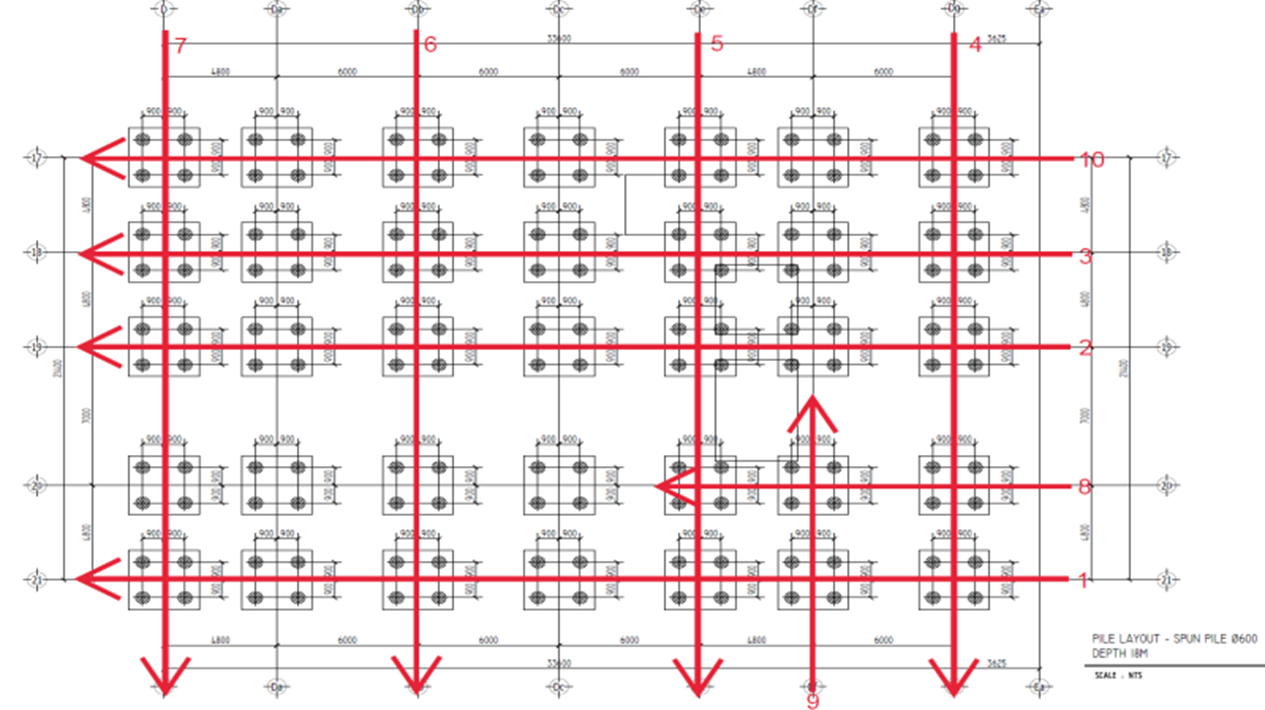Application of ground penetrating radar for evaluating foundation structure condition after earthquake
Abstract
At the time of seismic activity, the failure of the foundation structure will lead to building damage. When the West Pasaman 2022 earthquake occurred, PT. XYZ is constructing a feed mill tower. Since strong earthquake shocks were felt at the project location, foundation structure evaluation is needed to ensure the safety of the building. Ground Penetrating Radar (GPR) is a tool that is widely used to detect subsurface conditions. This study used GPR as a non-destructive testing technique to evaluate the condition of the foundation structure. The building evaluated is a high-rise steel building, using spun pile foundation. GPR test was carried out in specified lanes, with measurement tracks set at 10 lanes. Any cracks or fractures on the foundation will be indicated by the interruption of waves at the point of the crack or fracture. The GPR test results from readings of electromagnetic wave propagation showed that waves can reach the end of each foundation tested, ranging from 17.10 m to 17.82 m deep. It means that there are no cracks or fractures found on the slab, pile cap, or foundation. Analysis results showed that all slabs and pile caps thicknesses and the detected foundation piles depths are in accordance with the foundation design, which means that the foundations are still in good condition.
References
S. J. Hutchings and W. D. Mooney, “The Seismicity of Indonesia and Tectonic Implications,” Geochemistry, Geophysics, Geosystems, vol. 22, no. 9, Sep. 2021, https://doi.org/10.1029/2021GC009812
L. Budi et al., “Development of interactive e-module based on video and augmented reality for earthquake technology course,” Jurnal Pendidikan Teknologi Kejuruan, vol. 6, no. 3, pp. 179–189, Aug. 2023, https://doi.org/10.24036/jptk.v6i3.33623
R. P. Yanti, Suharsono, I. R. Palupi, and W. Hidayat, “Preventive Toward Earthquake’s Disaster in West Sumatera Based on Geophysic Analysis,” Jurnal Dialog Penanggulangan Bencana, vol. 8, no. 1, pp. 13–20, Jun. 2017, Accessed: Jun. 21, 2024. [Online]. Available: https://jdpb.bnpb.go.id/index.php/jurnal/article/view/113/113
M. Fadilah, E. Maryani, A. Permanasari, and R. Riandi, “Disaster-vulnerable community perception related to pre-earthquake natural phenomena in west sumatera as part of disaster preparedness,” IOP Conf Ser Earth Environ Sci, vol. 683, no. 1, p. 012075, Mar. 2021, https://doi.org/10.1088/1755-1315/683/1/012075
S. Bintialiumar, “The seismotectonic of West Sumatra,” J Phys Conf Ser, vol. 1317, no. 1, p. 012062, Oct. 2019, https://doi.org/10.1088/1742-6596/1317/1/012062
M. T. Rafie, D. P. Sahara, P. R. Cummins, W. Triyoso, and S. Widiyantoro, “Stress accumulation and earthquake activity on the Great Sumatran Fault, Indonesia,” Natural Hazards, vol. 116, no. 3, pp. 3401–3425, Apr. 2023, https://doi.org/10.1007/s11069-023-05816-2
D. Fernández-Blanco, M. Philippon, and C. von Hagke, “Structure and kinematics of the Sumatran Fault System in North Sumatra (Indonesia),” Tectonophysics, vol. 693, pp. 453–464, Dec. 2016, https://doi.org/10.1016/j.tecto.2016.04.050
X. Wang et al., “Oceanic plate subduction and continental extrusion in Sumatra: Insight from S-wave anisotropic tomography,” Earth Planet Sci Lett, vol. 580, p. 117388, Feb. 2022, https://doi.org/10.1016/j.epsl.2022.117388
I. I. Sianturi, D. Hamdani, and E. Risdianto, “Design an Earthquake Early Warning System Based on Arduino Uno Microcontroller with Accelerometer-MPU6050 sensor and NodeMCU-ESP8266,” Asian Journal of Science Education, vol. 6, no. 1, pp. 46–56, Apr. 2024, https://doi.org/10.24815/ajse.v6i1.36114
J. Mardizal, Y. Arbi, and I. Akmal, “Batang Bayang River Flood Modeling Based on Rain Return Period,” Jurnal Pendidikan Teknologi Kejuruan, vol. 6, no. 1, pp. 18–26, Mar. 2023, https://doi.org/10.24036/jptk.v6i1.31723
M. A. T. Windarta, D. J. Jaya, and S. Widodo, “Comparative study on using of SNI 1726-2012 and SNI 1726-2019 for calculating of internal force magnitude of lecture building in D.I. Yogyakarta Province,” IOP Conf Ser Earth Environ Sci, vol. 708, no. 1, p. 012011, Apr. 2021, https://doi.org/10.1088/1755-1315/708/1/012011
Z. Al Jauhari, A. Khafifah Nur, R. Aidil Fitrah, and S. Apriwelni, “Comparative study of SNI 1726:2012 and SNI 1726:2019 guidelines for response spectrum 2D method (study case: GKT II building of Bengkalis State Polytechnic),” E3S Web of Conferences, vol. 331, p. 05004, Dec. 2021, https://doi.org/10.1051/e3sconf/202133105004
I. Fajarrachman, Mr. Erizal, and M. Widyarti, “A Comparison of Rusunawa A4 IPB Building Storey Shear using Seismic Code of SNI 1726-2002 and SNI 1726-2012,” Asian Journal of Applied Sciences, vol. 6, no. 3, Jun. 2018, https://doi.org/10.24203/ajas.v6i3.5331
R. G. Wibowo, R. K. Rohman, and S. D. Cahyono, “Seismic Evaluation of Existing Building Structures in the City of Madiun using Pushover Analysis,” J Phys Conf Ser, vol. 1845, no. 1, p. 012032, Mar. 2021, https://doi.org/10.1088/1742-6596/1845/1/012032
M. Laia, “Earthquake Risk Area Mapping Based on Probabilistic Seismic Hazard Analysis (PSHA) Method and Microtremor Data in Nias Island,” Journal of Energy, Material, and Instrumentation Technology, vol. 4, no. 1, Feb. 2023, https://doi.org/10.23960/jemit.v4i1.200
M. Syarif, S. Astika, and A. Viddy, “Study on the Application of Earthquake Resistant Standards (SNI 1726: 2019) Against Building in Yogyakarta City,” in Proceedings of the 5th International Conference on Applied Science and Technology on Engineering Science, SCITEPRESS - Science and Technology Publications, 2022, pp. 148–153. https://doi.org/10.5220/0011729600003575
F. D. Raharjo, S. Syafriani, and S. Ahadi, “Estimation Model Peak Ground Acceleration at Bedrock and Surface of The Pasaman Barat Earthquake on February 25, 2022 M_w 6.1,” Indonesian Journal of Applied Physics, vol. 14, no. 1, p. 34, May 2024, https://doi.org/10.13057/ijap.v14i1.72221
B. G. Dewanto et al., “The 2022 Mw 6.1 Pasaman Barat, Indonesia Earthquake, Confirmed the Existence of the Talamau Segment Fault Based on Teleseismic and Satellite Gravity Data,” Quaternary, vol. 5, no. 4, p. 45, Nov. 2022, https://doi.org/10.3390/quat5040045
“2022 Sumatra earthquake - Wikipedia.” Accessed: Jun. 25, 2024. [Online]. Available: https://en.wikipedia.org/wiki/2022_Sumatra_earthquake
R. Imani, H. Kurniawan, and D. E. Sahputra, “Identification Of Damage Levels Of Residents’ Houses Due To Earthquake in Pasaman 2022,” Civil Engineering Collaboration, vol. 7, no. 2, pp. 35–41, Oct. 2022, https://doi.org/10.35134/jcivil.v7i2.46
J. Shin and K. Lee, “Investigation of Load-Bearing Capacity for Reinforced Concrete Foundation Retrofitted Using Steel Strut–Tie Retrofit System,” Sustainability, vol. 15, no. 13, p. 10372, Jun. 2023, https://doi.org/10.3390/su151310372
F. Kaladi, F. Wang, and F. Z. Kherazi, “Structural Stability: A Comprehensive Review of Pile Foundations in Construction,” Journal of Asian Development Studies, 12(4), 412-425. 2023. https://doi.org/10.62345/
M. A. Ramadhan, S. S. Handoyo, and W. Cahyati, “Trends of Vocational Education and Training Research in Building Construction Engineering,” Jurnal Pendidikan Teknologi Kejuruan, vol. 4, no. 2, pp. 47–52, Nov. 2021, https://doi.org/10.24036/jptk.v4i2.20723
B. J. Abbas, H. Yousif Aziz, and R. T. Alkateeb, “Structural Rehabilitation of Damaged Building Due to Cracking,” International Journal of Civil Engineering and Technology, vol. 9, no. 8, pp. 1346–1352, 2018, [Online]. Available: http://iaeme.com/Home/issue/IJCIET?Volume=9&Issue=8http://iaeme.com
B. Sayin, B. Yildizlar, C. Akcay, and T. Cosgun, “Damages in adjacent structures due to foundation excavation,” in Fourth International Conference on Advances in Civil, Structural and Environmental Engineering - ACSEE 2016, Institute of Research Engineers and Doctors, Dec. 2016, pp. 77–81. https://doi.org/10.15224/978-1-63248-114-6-28
N. Tanasić and R. Hajdin, “Management of bridges with shallow foundations exposed to local scour,” Structure and Infrastructure Engineering, vol. 14, no. 4, pp. 468–476, Apr. 2018, https://doi.org/10.1080/15732479.2017.1406960
J. G. Atat, I. O. Akpabio, and N. J. George, “Allowable Bearing Capacity for Shallow Foundation in Eket Local Government Area, Akwa Ibom State, Southern Nigeria,” International Journal of Geosciences, vol. 04, no. 10, pp. 1491–5000, 2013, https://doi.org/10.4236/ijg.2013.410146
Z. Citra, P. D. Wibowo, Y. Malinda, A. Wibisono, R. Apdeni, and Herol, “Testing of Concrete Structures with Non-Destructive Test Method (NDT) Using Ultrasonic Pulse Velocity (UPV) at the Building on the Ancol Beach,” CIVED, vol. 11, no. 1, pp. 217–225, Mar. 2024, Accessed: Mar. 31, 2024. [Online]. Available: http://cived.ppj.unp.ac.id/index.php/CIVED/article/view/530/192
“Ultrasonic Pulse Velocity Test-Procedure, Applications, Advantages.” Accessed: May 21, 2024. [Online]. Available: https://testbook.com/civil-engineering/ultrasonic-pulse-velocity-test
Dr. G. S. Budi and L. S. Tanaya, “The Effect of Welded Splice with Predetermined Gap of Concrete Spun Pile on The Response of Low Strain Integrity Test,” Civil Engineering Dimension, vol. 24, no. 2, pp. 109–114, Oct. 2022, https://doi.org/10.9744/ced.24.2.109-114
Z. Citra, Y. Malinda, P. D. Wibowo, R. F. Ashadi, A. Wibisono, and R. Apdeni, “Inspection of Foundation Structures with Pile Integrity Test (PIT) of Steel Tower Building,” Rekayasa Sipil, vol. 18, no. 2, pp. 136–141, Jun. 2024, https://doi.org/10.21776/ub.rekayasasipil.2024.018.02.10
“Pile integrity test (Low strain impact integrity testing).” Accessed: May 21, 2024. [Online]. Available: https://www.geotech.hr/en/pile-integrity-test/
R. V. Jaya Saputra and C. Kuo, “Ground Penetrating Radar Signals, An Efficient Way to Estimate Fouled Ballast,” Indonesian Geotechnical Journal, vol. 2, no. 3, pp. 1–8, Dec. 2023, https://doi.org/10.56144/igj.v2i3.45
D. Parwatiningtyas, “Application of the GPR (Ground Penetration Radar) method for soil investigation and building structure analysis test,” J Phys Conf Ser, vol. 1816, no. 1, p. 012003, Feb. 2021, https://doi.org/10.1088/1742-6596/1816/1/012003
D. Zhou and H. Zhu, “Application of Ground Penetrating Radar in Detecting Deeply Embedded Reinforcing Bars in Pile Foundation,” Advances in Civil Engineering, vol. 2021, pp. 1–13, Apr. 2021, https://doi.org/10.1155/2021/4813415
N. KhoderAgha and G. Assaf, “Assessment of Ground Penetrating Radar for Pyrite Swelling Detection in Soils,” Civil Engineering Journal, vol. 10, no. 3, pp. 729–737, Mar. 2024, https://doi.org/10.28991/CEJ-2024-010-03-05
M. S. Abdullah, H. H. Karim, and Z. W. Samueel, “Investigation structural settlement by Ground Penetrating Radar (Case study),” IOP Conf Ser Earth Environ Sci, vol. 961, no. 1, p. 012037, Jan. 2022, https://doi.org/10.1088/1755-1315/961/1/012037

Copyright (c) 2024 Risma Apdeni, Zel Citra, Fitra Rifwan, Prima Yane Putri, Nevy Sandra, Yosie Malinda, Paksi Dwiyanto Wibowo, Reza Ferial Ashadi, Annisa Prita Melinda (Author)

This work is licensed under a Creative Commons Attribution 4.0 International License.









